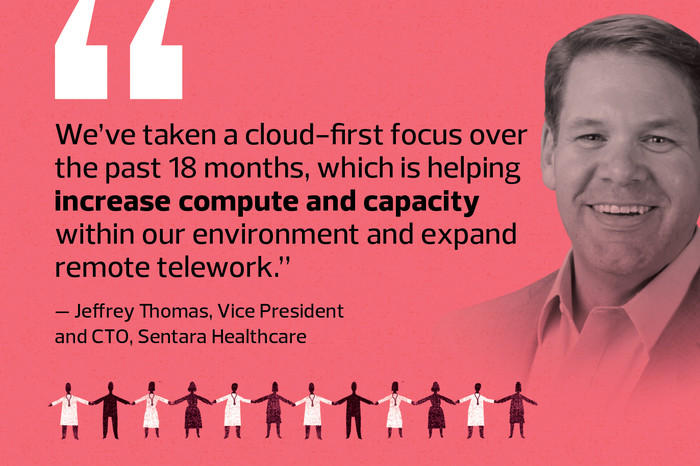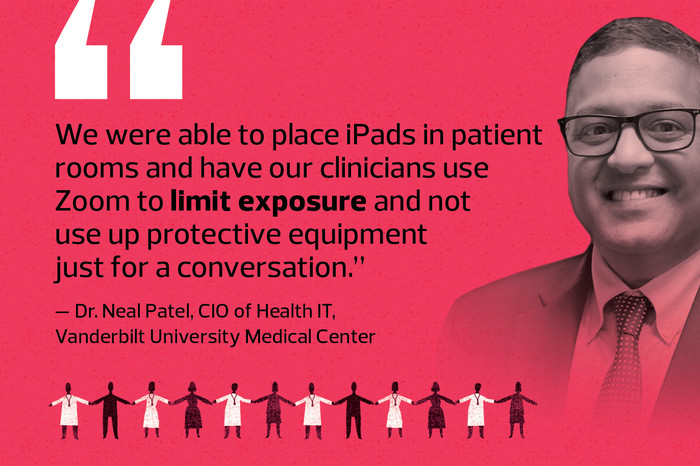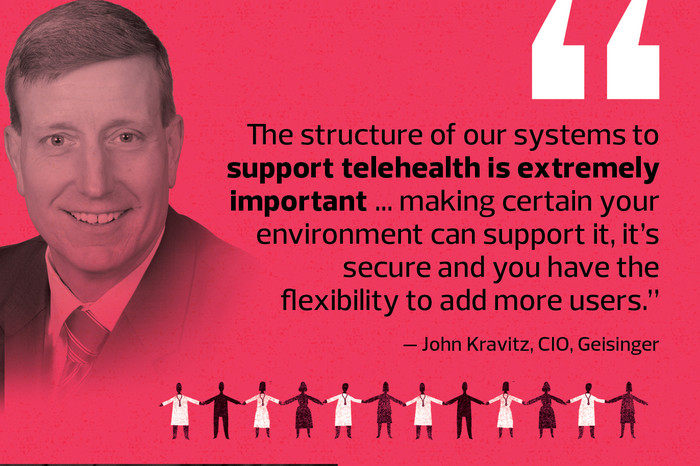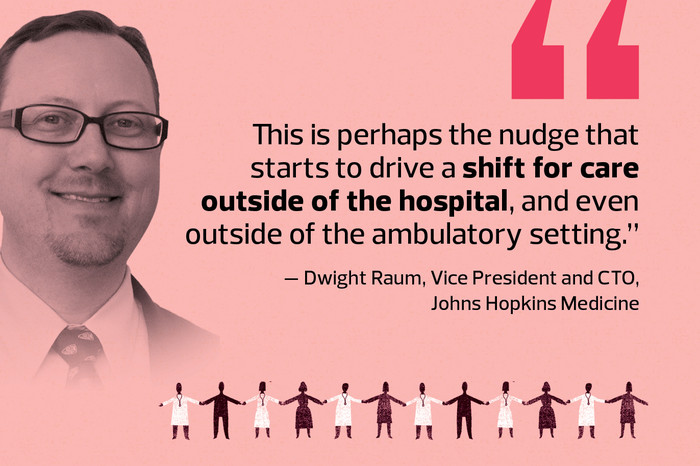As a global pandemic puts clinicians to the ultimate test, healthcare IT teams also face numerous related challenges to ensuring business continuity and patient care.
Among their critical tasks: addressing a surge in telehealth demand, equipping outdoor tents and screening stations, and provisioning devices for thousands of employees to work safely from home via virtual networks.
The fight against COVID-19, leaders say, has brought out the quick thinking and compassion that has always been at the heart of healthcare IT — qualities that are in high demand as organizational needs and workflows change by the minute.
“We are all aligned to work together for the patient and the provider,” says John Kravitz, CIO at Geisinger. “This has always been our top priority.”
HealthTech recently spoke with Kravitz and other leaders on the front lines: Dr. Neal Patel, CIO of health IT at Vanderbilt University Medical Center; Dwight Raum, vice president and CTO at Johns Hopkins Medicine; and Jeffrey Thomas, vice president and CTO at Sentara Healthcare.
Each spoke about planning, pivots and best practices during a complex time, and how current arrangements may influence future care delivery.
READ MORE: Discover five ways healthcare tech is helping tackle coronavirus.
HEALTHTECH: How crucial are healthcare IT teams right now?
RAUM: We’re physically changing how our hospitals are working. As we move people around, our teams are shifting huge amounts of hardware, networking and telecommunications infrastructure. There’s a tremendous amount of transition going on as this unravels. IT teams must be committed to supporting that change, wherever it is.
KRAVITZ: Our staff is supporting the organization all over, setting up these tents for screening or treatment; they’re like a MASH unit. They’ve got all the IT equipment; we run fiber optic cables in and out and those tents. We put all the equipment in there, even medication dispensing machines, the lab label printers, stuff like that. It’s commonplace for us now.
PATEL: Part of IT is to be consultative and make an experience as seamless as possible, rather than just taking on tasks. During a time of stress, people ask for the first thing that they can think of. If someone says, “We need a laptop,” my team knows you’re also probably going to need a label printer and a printer for discharge instructions.
THOMAS: Providing access to information and support and rapidly deploying new capabilities are crucial. We’ve taken a cloud-first focus over the past 18 months, which is helping increase compute and capacity within our environment and expand remote telework. If anything, this is accelerating us down the path we were already going.
HEALTHTECH: In what ways have you expanded virtual care?
RAUM: We’ve been shifting many of our encounters to be either video- or voice-enabled. And it’s important that I don’t think we have been overly strict in defining what a telemedicine visit looks like. We’ve essentially empowered and enabled clinicians with some looser guidelines to really run with the technology. They are flexible and ready.
PATEL: We have been able to leverage our patient portal with Zoom, our telecommunications platform, not only for telehealth appointments but within the hospital. We were able to place iPads in patient rooms and have our clinicians use Zoom to limit exposure and not use up protective equipment just for a conversation.
THOMAS: Telehealth also allows us to extend our medical providers to still be able to provide care without physical contact. They can practice or conduct some virtual rounds via video through a mobile device; we use a telemedicine cart or handheld device at a patient’s bedside to enable this capacity.
KRAVITZ: A lot of patients, especially the elderly, are afraid to come into an acute care setting. It’s really about communication messaging on telehealth — whether via patient portals or an email or text message blast. Targeted marketing is so important: We’re here to care for you and we’ll do everything we can to make it a better experience.
DISCOVER: Learn how technology guides care and comfort during a health crisis.
HEALTHTECH: What needs are affecting your infrastructure?
PATEL: We absolutely have had to expand our capacity at the internet perimeter. We also had to expand VPN licensing — because a lot more of us are now utilizing it — as well as our Zoom licensing. We just held a virtual town hall with 450 health IT people to talk through issues and priorities. Being able to see other faces, I think, was empowering.
RAUM: We’ve never really been able to effectively test these things at the scale that they're being used right now. We encountered a couple of little hiccups here and there and with the VPN, but most of our users probably didn’t even notice. Our challenge here has been mainly around monitoring and making sure we have sufficient headroom in how our users are taking advantage of the technologies.
KRAVITZ: The structure of our systems to support telehealth is extremely important. I have embedded IT resources in that department. Just like any other program, it’s about making certain that your environment can support it, that it’s secure and that you have the flexibility to add more users.
THOMAS: The biggest issue I see is the internet infrastructure within the United States and its consistency to our home users and the cellular networks. We are now dependent on those systems supporting telemedicine and other applications. That work used to be concentrated in manageable office systems where we knew the bandwidth.
HEALTHTECH: How did you enable staff to work from home?
PATEL: We had to really think about what type of devices are going to be at home: How are they going to connect to our network, and what kind of issues will that bring? Many of our staff do not have laptops at home, and we weren't traditionally giving many of them laptops because they have machines at work.
THOMAS: We’ve moved about 40 percent of our enterprise applications into the cloud, where we’ve started to spin up Windows virtual desktops. That allows us to expand our capabilities beyond traditional VPN access or the internal Windows VDI that is usually in data centers to meet the needs of up to 5,000 new users who had never worked remotely.
Learn how Sentara Healthcare is making the most of its virtualization strategy.
KRAVITZ: We have about 13,000 people working remotely. We are predominantly using VMware for connectivity, with multifactor authentication to protect the security integrity of our enterprise. Many laptops and desktops are preloaded with VDI capability, and our service desk can handle concerns efficiently.
RAUM: We’re using Citrix to virtualize the application experience altogether so that there is never any data really going out of our enterprise and into an unmanaged environment. We also use a special type of Microsoft VPN technology called DirectAccess. Our workstations have all of the security controls and encryption we need.
HEALTHTECH: What has been central to business continuity?
THOMAS: We follow the standard business continuity disaster recovery playbook that every IT organization uses, making sure that we have an inventory of all assets and where we have them. We also look at our reserves and supplies and how we can then leverage those to meet business needs and the criticality of the situation.
RAUM: Connectivity is probably the biggest single piece. That means having not only the network capacity and the tools to allow it, but also the proper applications and communications between staff. We use Microsoft Teams; some of us use Slack. There has been really good flexibility in adoption of these tools.
PATEL: We need to make sure our systems work, but we also need to share information. One of the key things we did was to create a COVID-specific website and a mobile app for our employees so they can get the latest information — not just patient care guidelines, but also what’s happening with PTO, staffing, changes in visitation policy.
KRAVITZ: Understanding the pressures that our operations team working with the patients is experiencing is extremely important, as well as making sure we’re providing every service a patient might need. We do have a bot and other things that help with screening. We have nurses in contact centers who can take them through a very ordinary process and try to put their fears to rest.
HEALTHTECH: How might current operations shape future care delivery?
THOMAS: We have to rethink our model for delivering services and providing services outside the hospital and data center environments. That’s where cloud, a cloud-enabled model and a digital app to provide those services — and the ability to integrate them into your care system and normal workflows within a hospital — is so important.
PATEL: The work of our administrative folks is a huge testament to discovering that a lot of work can be done offsite. All of our meetings have become virtual meetings, and there are good points and bad points about that. But it basically forced everybody into the same boat, and I think it’ll pay dividends in people's comfort level with technology because, in a time of crisis, they were forced to do it and realized it wasn't so bad.
RAUM: This is perhaps the nudge that starts to drive a shift for care outside of the hospital, and even outside of the ambulatory setting, with the broader adoption of digital health tools. Whether it’s sensors in the home or apps on your phone, technology-driven digital interventions can be used to diagnose or intervene in patient care.
KRAVITZ: Because of this crisis, I’m very hopeful we’ve learned where telemedicine can really meet the needs of our patients. I am also hopeful that the federal government, with Medicare, and commercial insurers will see that this could work in everyday living and simplify healthcare to a great degree going forward.
Want more on how to maintain your healthcare operations during a disruption? >>> Watch a CDW Healthcare webinar about best practices for business and care continuity.















